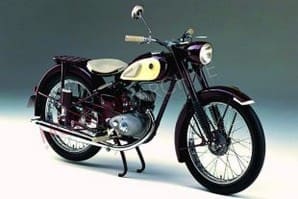
Yamaha 1955- Japan
Born in 1851 at Wakayama, Torakusu Yamaha began a 10-year engineering apprenticeship in Nagasaki, often tutored by an English clockmaker. He soon learnt an appreciation of highly accurate precision engineering. Aged 30 Torakusu started a further apprenticeship at a medical shop in Osaka. A few years later he carried out a medical equipment repair job at the Hamamatsu Hospital and was captivated by the surrounding area. Later, the president of the hospital, advised the principal of the local Hamamatsu Elimentary School of Yamaha's expertise, who was summoned from Osaka, to repair the school's near new American built organ. A job he successfully completed with help of metal worker Kisaburo Kawai, despite having never worked on such a complex instrument.
Now captivated by organs, Yamaha helped by Kawai, scratch-built their version of a harmonium, which according to folklore they carried 200 miles from their workshop to the Tokyo University of Art for assessment. The University condemned the instrument for imperfect tuning but was impressed by Yamaha's enthusiasm. Invited to listen in on University lectures he later returned home to build another improved instrument, which was approved by the musical academics. Soon Torakusu began to receive orders for his instruments and set up in business with Kisaburo Kawai as Yamaha Organ Manufacturing to build their harmoniums in an old disused temple in Sugawaracho, Hamamatsu. Within a year sales were running at 250 organs per year and rising.
Enjoy more Classic MotorCycle reading in the monthly magazine.
Click here to subscribe & save.
Soon the business was joined by the president of the Hamamatsu Hospital, Tomisaku Fukushima but despite full order books and much public acclaim the partnership turned sour and Yamaha went his own way to establish Yamaha Musical Instrument Manufacturing, which was again successful and during the boom years after the Sino-Japanese war, struggled to fulfill huge demands for more and more of their superb organs.
Later, Yamaha was joined in business by Nippon Gakki who was able to inject further cash into the company and create a fruitful partnership which lasted until Torakusu's early death in 1916, aged 64. In 1900 Yamaha began making pianos, five years later they won top honours for their musical instruments at the 1905 World Exposition, St Louis, USA and in 1913 Chiyomaru Amano, governor of the Hamama District joined the company as vice-president. The year Yamaha died (1916) a new factory, which later became the site of the company's (Nippon Gakki) headquarters, was built in Nakazawacho, Hamamatsu City.
Amano became president in 1916 and initially all went well with further capital being raised and more factories opening including one with a 600 female workforce making harmonicas. Unfortunately, due to natural problems such as the 1923 earthquake, which flattened their Tokyo factory and Amano's perceived mishandling of labour relations issues, Nippon Gakki (Yamaha) went into severe decline until Chiyomaru Amano was replaced by 43-year-old Kaichi Kawakami. He was a brilliant engineer and a star student at Tokyo University. With personal sacrifice, foresight, a responsibility to his workforce and imagination, Kawakami turned round the Nippon Gakki's fortunes. Again the company gained worldwide renown, as it still does today.
In 1950 Kaichi retired from his presidency due to long term ill health, but for years he'd trained his son Gen-Ichi for the role of Nippon Gakki president. Kawakami, like his father, was a natural leader and instructor who was later to become another worthy giant of Japanese industry. It was Gen-Ichi who oversaw the establishment of another super successful sibling, Yamaha Motor of which he was president along with being president of the parent company Nippon Gakki. In honour of Torakusu Yamaha and due to the company's worldwide musical associations, Yamaha motorcycles proudly sport the parent company's logo of three tuning forks.
Quite why Nippon Gakki decided to enter the Japanese motorcycle market as a manufacturer in the mid-Fifties is unclear. They couldn't have picked a worse time to create a brand, especially as they'd never made motorcycles before and their workforce was experienced in the manufacture and assembly of musical instruments including pianos, organs and the like but with no experience of motorcycle engineering.
Added to this the Japanese motorcycle market was chaotic and cut-throat with over 100 makers including Honda, Tohatsu et al, each competing for a share of a finite market. However, the potential of a yet untapped by the Japanese export market, especially in Europe and the Americas, was immense. Where Kawakami's sights were pointing is unknown, but perhaps he'd the foresight to think of these markets.
Having made the decision to make motorcycles Gen-Ichi Kawakami sent his chosen engineers on expeditions in Japan and round the world. Their mission was two-fold, to discover designs plus production procedures of other companies and also come back with a proven product which could be copied, improved and developed to give the future Yamaha Motor company the best chance of success. From the outset Gen-Ichi decided to give the motorcycles a publicity advantage by starting a racing team.
As Soichiro Honda on his visit to Europe in the mid-Fifties admired the production, design and race team management of the German NSU factory so too did the Nippon Gakki engineers find most of their answers in Germany. They knew they could put a motorcycle like the DKW RT125 into production in Japan and it would sell. Also, they were impressed by German motorcycle manufacturing procedures and quality.
DKW designed and developed the RT125 at their Zschapau works with the machine ready for production in 1939. The 123cc, three-speed two-stroke was built almost continuously during the war years as lightweight transport for Wehrmacht solo dispatch and liaison duties. Historical sources suggest 33,000 were built 1940-44.
After the war, DKW relocated to Ingolstadt, Bavaria, (Western) Germany while IFA Motorcycle Manufacture, later MZ, took place at the former DKW plant. In 1949 DKW restarted production of the RT125 and its one of these machines on which the first Yamaha, the YA-1 was heavily based. During 1954 and early 1955 Nippon Gakki engineers worked on design, prototypes and readying the model for production at the Hamama factory.
Assembly and finish of the red motorcycle, with cream tank panels, was undertaken by a small production team, which included many staff pulled from the piano manufacturing division. The 125cc single cylinder two-stroke motorcycle was nicknamed Akatombo (the Red Dragonfly) due to its finish. Soon 300 machines were built and sold each month and after three years more than 11,000 motorcycles had been built by the Nippon Gekki motorcycle division, which traded under the name Yamaha Motor.
Having put the YA-1 into production Yamaha Motor then established the planned racing team under the leadership of Zenzaburo Watase who has become one of the legends of Yamaha racing history. Using the YA-1 as a starting point the first factory racing Yamahas were built.
First outings were at the Mount Fuji sprint (timed hill climb) and a team entry for the first Asama Volcano Road Race. The road race circuit comprised a track with a packed volcanic ash surface constructed at the foot of Mount Asama. Despite being a complete unknown, by teamwork, extensive study of the opposition, machine development and daring riding, Yamaha won both events. Suddenly the tiny YA-1 was the machine to be seen on for many young Japanese enthusiasts.
Over the next three years Yamaha Motor developed the YA-1, improvements included increasing the power output in stages from 5.5bhp to 9bhp. At the same time new models were considered including the YC-1, a 175cc single cylinder motorcycle, again heavily based on DKW design. Senior management wanted a 250cc motorcycle and instructed the development team to build a near copy of what they considered the best 250cc two-stroke twin, the Adler MB250. The engineers squirmed and after a meeting with Nippon Gakki and Yamaha Motor president Gen-Ichi Kawakami, they were allowed to design their own motorcycle, but failure would not be tolerated!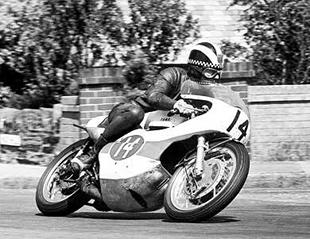
The resulting pressed steel framed 247cc twin cylinder two-stroke YD-1 bears more than a passing resemblance to the Adler MB250, especially with regard to bore and stroke dimensions of 54 x 54mm and crankcase design and assembly. But many features, including piston design, combustion chamber design and cylinder porting, owed much to the Yamaha design technicians who had learnt from both roadster and especially racing motorcycle development. Happily for all, the resulting motorcycle was again a production and sales success.
Due to the tightening of racing regulations factory teams were only permitted to run two motorcycles in any class at selected important events. Further entries were permitted if the machines were of a different design. To this end, the team for the 1957 Mount Asama Road Race comprised 2 x 125cc YA-1s with 54 x 54mm engine dimensions and 2 x 125cc x YA-1s with 56 x 50mm engine dimensions. The YD-1 250 twins were simply a double up of preceding dimensions. At this meeting they were first and second in the 125cc race and first, second and third in the 250cc race. This was more super publicity for Yamaha and president Kawakami who called his staff together to detail his plans for future strategy. But the immediate future was to be one of mixed fortunes for Yamaha.
In 1959 Yamaha introduced the tubular steel framed YDS-1 with updated but familiar twin cylinder 247cc two-stroke engine. Developments of this machine served Yamaha for the next 20-plus years on the roadster two-stroke front. While this move was again successful, the proposed move into the scooter and moped world couldn't have been worse for Yamaha Motor.
The 175cc two-stroke SC-1 scooter with monocoque plastic body, was pleasant enough, even with its typical Japanese type styling and odd triangulated single side front fork and the MF1 50cc semi-moped step-thru, wasn't too far off the mark but both models were beset with teething troubles. Later the problems with the MF-1 were to do immense damage to Yamaha Motor's reputation and to compound all of this a sizeable number of customers for the two-stroke scooters weren't enthusiasts who understood the principles of two-stroke lubrication and often forgot or omitted to add the oil to the petrol each time they filled up. Expensive engine seizures make for bad publicity.
Suddenly the value of Yamaha Motor shares plummeted on the Tokyo stock market and then shareholders weren't paid any dividends. The situation became extremely serious but in the nick of time Kawakami appointed Hisao Koike as the new Yamaha Motor sales director who rapidly set up a new marketing structure and also shook up the development engineering team. One of their new concepts was the Yamaha Autolube engine lubrication system, which in basic terms, pumps a metered oil supply into the engine on demand, taking the responsibility away from the rider who had to do nothing more than ensure the oil reservoir had enough appropriate oil in it. Autolube was an outstanding success story and sales again increased.
Against this background Yamaha Motor was already moving into the international road racing scene. Their start was in 1958 when two works Yamahas 250cc (249cc, 56 x 50mm) racing twins were taken to Catalina on the American Pacific coast. The event, competition and course were nothing like the Yamaha team had ever seen. The circuit comprised a rough, bumpy six mile gravel track. As Itoh lined up his Yamaha YD-1 based racer he'd no idea what would happen next. Struggling to keep on the track and maintain some sort of race speed he was felled by another rider, which damaged his machine including a sparking plug. After limping back to the pits for a plug swap he rejoined the race last, but then carved his way through the back markers and middlemen to take the chequered flag in sixth place. Both he and Yamaha were delighted and they knew much better was yet to come.
Yamaha scored their first international Grand Prix points and IoM TT top six finish simultaneously in the 1961 IoM Lightweight 250cc TT with Fumio Ito's sixth place. The first GP win was again thanks to Ito at Spa-Francorchamps, Belgium in 1963 with team-mate Yoshikazu Sunako runner-up. Phil Read notched up the first Riders World Championship a year later and with back-up from Mike Duff, Tommy Robb and others Yamaha won the constructors’ title too. Phil Read not only clinched the 1965 250cc world title also but scored the factory's first IoM TT win in the three lap Lightweight 125cc race with an average race speed of 94.28mph.
Back to production motorcycles and Yamaha continued to develop their range but alongside this, split the road racing activities into two divisions. One looked after the works motorcycles and development while the other was customer based to focus on developing an over the counter racer. Work which first led to the TD series, which proved good at club level, but with the launch of the TD1C of 1967, buyers were able to buy an over the counter racer which was a potential national winner straight from the box. And as later proved, was more than able at international GPs too. During the Sixties Yamaha became the most effective two-stroke racing motorcycles ever seen on both the national and international circuits.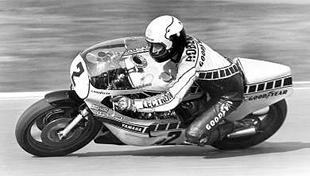
By 1965 Yamaha Motor production had risen from 300 machines per month a decade earlier to 13,000-plus units per month. Albeit still small volume compared with giants Honda, but to have reached 150,000-plus motorcycles annually from a standing start 10 years earlier was creditable and due in no small part to their design department who developed eye catching, reliable motorcycles which to many fans were a breath of fresh air.
Arguably the backbone of the Yamaha range during the swinging Sixties was the progressive development of the successful 250cc (247cc) twin cylinder two-stroke range. The 247cc YDS-1 launched in 1959 led to the YDS-2 unveiled in 1962 and then the 1964 onwards YDS-3. Later, came the DS-7. With much race-bred development, these attractive touring 250s led to the launch of the fast RD series built in a range of capacities, of which selected models first appeared in 1973. The machines were quick on the road and performed well at clubman level and in street classes on the track.
Alongside these, Yamaha continually unveiled more and more super lightweights, which were all accomplished 'proper' motorcycles. Favourites included the 123cc single cylinder two-stroke YA-6, which although in appearance and design was worlds apart from the launch model YA-1, they were siblings; the dashing 73cc Yamaha Eighty Sports YGS-1 of 1967, along with its touring sister the Yamaha Eighty YG-1. And how many of us style conscious teenagers of the Sixties lusted after the 100cc twin cylinder YL-1? The following quote from the 1967 catalogue illustrates why the tiny gem hit the spot perfectly.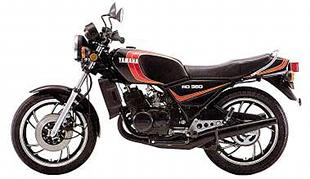
“In the YL-1 Yamaha have come up with a miniature masterpiece; a twin cylinder 100cc engine which will hold its own with many machines of twice its engine size. It has twin matched carburettors, twin tuned silencers, separate twin cylinders and many engine parts which are made to aircraft engine limits. With its light frame and damped springing this new Yamaha is responsive and handles splendidly in dense traffic. It has real ‘get away’ when it reaches the open road.”
With five riders' Grand Prix World Championships, five World constructors' titles, 61 Grand Prix wins in the Lightweight 125 and 250 classes including five IoM wins and hundreds of international places during the Sixties, Yamaha had taken their place on the worldwide racing stage. A place supported ably when the TD1C replaced the TD series 1967 to rapidly become the 250cc over the counter racer to run. Although Yamaha have long claimed they never made a profit on such machines they took endless riders to club, regional, national, and even international wins. Additionally, they'd developed an envious position throughout much of the world as the maker of superb lightweight roadsters. But as the Sixties drew to a close another problem was looming which Yamaha would have to address thanks to one of their largest export markets, the USA.
Clouds were building in the US regarding the prospect of anti-pollution legislation, which would become law in the early Seventies. In typical Yamaha manner they spotted the prospect before the legislation was implemented, took it on the chin and began development of four-strokes. A policy which saw their two-stroke range diminish as they launched one after another of top four-stroke machines with one, two, three or four cylinders and either chain or shaft drive.
However, two-stroke development wasn't forgotten and many consider they came of age in 1975 when former MV Agusta star Giacomo Agostini secured their first rider's title in the then blue riband 500cc Grand Prix World Championship. Titles continued coming for Yamaha riders including Americans Kenny Roberts, Eddie Lawson and Wayne Rainey in the 500cc class, German, Deiter Braun, the legendary Fin, Jarno Saarinen, British runner Rod Gould and Tetsuya Harada from Japan in the 250 class and many more.
However, before focusing on the four-stroke roadster market, Yamaha had another new two-stroke act up their sleeve, the 175cc DT1 (Dirt Trail). Aimed at the American market, it offered 60mph on the road and proved highly competent off road. This was to lead to many more 'dirt classics' including a range of DT two-stroke models from 50cc to 400 (DT50, DT175, DT400 etc) and then in 1977 came the immortal four-stroke single cylinder XT500 which has led to a host of models with even larger single cylinder motors. Against this background of superb trail motorcycles, Yamaha launched trials models in a range of capacities coded TY and out and out motocross machines, beginning with the YZ250 in 1974.
Having had a long look at the then best 650cc parallel twin, the Triumph Bonneville, which was still earning useful income for the Meriden factory in the lucrative US market, Yamaha took on the challenge. And head on too, by launching in 1969 the sophisticated XS1 with 653cc ohc engine, five-speed gearbox and electric start. Initially with dodgy handling and road holding it wasn't one of Yamaha’s best products, but they had faith and relaunched a revised design as the XS650. Although a fast touring motorcycle, race prepared engines went superbly on the US flat tracks, powered motocross sidecar outfits around the world and was put to many other non touring roles including on the grass, at sprints and on the hill climbs. Briefly they tried a 750cc version, but its two, contra rotating, balance shafts successfully cut the vibes and the power! It was dropped quietly.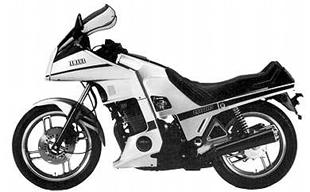
Although four-strokes were to ensure a secured future, two-strokes weren't forgotten. For the commuter market Yamaha built the reed valve V50 and V80 step-thrus sporting two or three speed automatic gearboxes with manual selection. Sports mopeds crept around the UK sixteener legislation; implemented to restrict 16-year-olds to under 50cc machines with pedals. And in 1978 the British government decided a 50-plus mph Yamaha moped, or Kreidler, or Puch or… from their rivals didn't fit the bill, or rather Act! Legislation was refined to restrict 16-year-olds to under 50cc machines restricted to 30mph, but gone was the requirement for pedals, and so too for youngsters was the fun. Yamaha's sports moped, the FS1 and derivatives, including the much sought after FS1E (Fizzie), were unrestricted until 1978. Later restricted and fitted with disc front brake (1979), it became the FS1DX.
Keeping to the two-stroke front, the YDS derived series, which had served Yamaha so well, was phased out and replaced by the RD (Race Developed) series. Featuring 'Torque Induction,' a redesigned version of reed valve induction, the RD series gave a far wider band of aggressive power than the company's earlier two-strokes. For once, improvements were without cost on the road as the RDs were more economical and tractable than earlier models. The RD series range comprised 125, 200, 250 and 350cc with six-speed gearboxes to the 250/350cc versions. In 1975 the range was updated with squarer (coffin) tank and later the RD350 grew to 400cc. The RDs gained electronic ignition in 1978 and was phased out in 1980. The Americans finally had their way and ruled it environmentally unfriendly.
As the Seventies rolled on, Yamaha worked on more four-stroke roadsters including the twin cylinder dohc XS 500 twin. With balance shaft to smooth the engine it dished out a healthy 48bhp at 8500rpm which was enough for around 110mph but its handling came into the average category, especially by standards the world had come to expect from Yamaha. Later (1976) in the same family, came the sohc XS360 with 180 degree crankshaft and then the XS250, which to many looked large for a 250 but was well respected. Finally, the XS360 grew to the XS400 which with dohc cylinder head and lasted until 1983.
Although Yamaha knew the writing was truly on the wall for two-stroke roadsters they still weren't done with the concept in the light/medium weight sporting stakes. As the RD slid from the catalogue in came the LC (Liquid Cooled) or 'Elsie.' Offered initially in 250 and 350cc form, the reed valve six-speed model had more rounded bodywork than the preceding RD models and gained a monoshock rear suspension directly from the motocross YZ range.
Elsies weren't only great fun on the road but were an effective tool in production racing, either straight from the box or with the benefit of engine development. So good were the LCs that many fledgling racers were told to learn to race it as fast as it would go before racing engineers would begin to extract more power from them. In their first IoM TT, Elsies won the 250 and 500cc Production classes.
In 1982 the LC range gained YPVS – Yamaha Power Valve System – in effect a variable exhaust port, which changed in size and position as engine revs altered. Then came the fastest ever production Elsie roadster, the LC500. An 80bhp V4 two-stroke with YPVS and a 135mph top speed, it was huge fun but with a huge thirst when caned.
Although Yamaha had witnessed the success Honda, Suzuki and Kawasaki were having with their transverse fours they at times seemed less than keen on the concept. In 1981 the 981cc 75 degree V-twin TR1 was unveiled, then came its stable mate 740cc shaft drive Virago which sold well enough to lead Yamaha to produce a whole series of Viragos from 125cc learner machines up to 1100cc versions. In the early Eighties their designers seemingly lost the plot to give us the XZ550, launched in 1982. Briefly a dohc 552cc V-twin with four valves per cylinder, so far so good, but its balancer shaft was hung from the frame down tubes and trailing axle front forks finished the bizarre plot off.
At the same time as the XZ550, Yamaha were working on another project which would ultimately bring them big bike touring fortune. Starting quietly with the dohc transverse four cylinder XJ550 and shaft drive 650 and 750cc (XJ650 and XJ750) versions, they first looked for more power by trying a turbo unit, giving the XJ650 Turbo which was pleasant enough but suddenly the penny clicked – touring was made easy with bigger fours.
They began with the launch of the air-cooled 853cc dohc transverse four cylinder XJ900. Increasing engine capacity to 891cc gave the popular 91bhp FJ900, which remained in production into the 21st century, while another increase in engine capacity led to the 1984 FJ1100. Finally, came the 125bhp, 148mph FJ1200, which even had the option of ABS. Although now out of production for some years, many heavily overloaded FJ1200s reliably cruise the highways and autobahns of Europe each year.
Just on the cusp of our self-imposed cut off date was the launch of one of the maddest motorcycles ever conceived by Yamaha Motor. Using the old adage that a good motorcycle is one with such a large engine you can't spit through the frame, the V-Max, with its chassis filling 1198cc liquid cooled V-4, was a sure winner. And so it proved. A leader of the muscle bike cult, the V-Max was powered by a touring Yamaha XVZ12 engine upgraded with larger bore carburettors and valves for more power while the bottom end was strengthened to cope with the endless abuse V-Max riders enjoy meting out on their motorcycles.
Again on the cusp of our 25 year rule was Yamaha's first foray into the sportsbike market with the 749cc dohc transverse four cylinder 106bhp FZ750 with five valves per combustion chamber. Briefly, later models included the 1002cc/135bhp FZR1000. The claimed 165mph machine was Yamaha's first with alloy box section frame (Deltabox). In 1989 the FZR range gained Yamaha's EXUP – Exhaust Ultimate Power Valve. The FZR range later grew to include the pretty race replica FZR400R. And in 1996 the FZR600 and FZR1000 gained new names, Thundercat and Thunderace respctively.
Further models include the XT600Z Tenere, which gained fame in long distance predominantly off-road events such as the Paris-Dakar rally, the big single cylinder road-going SR series, launched decades ago as well as such favourites as the 608cc SRX600. Other more recent models include the 1990 launch of the 849cc V-twin TDM, the four-cylinder 600 Diversion unveiled in 1991 and later 900 version, while towards the end of the Nineties came the value for money FZS600 Fazer. This led to a range of capacities and for those who wanted race bred motorcycles, the YSF-R1 and YSF-R7 of 1998 and a year later the superb handling 600cc YSF-R6 with a claimed top speed of 170mph and usable rev range of up to 15,500rpm.
Having made such a wide range of motorcycles over the past 50 years it's impossible to do more than scratch the surface. Models omitted include learner legal machines like the SR125, twist and go scooters exampled by the CW50 Bi Whizz, the shaft drive four-stroke step-thru T50 and T80, Majesty scooters, custom cruisers including the XVS Royal Star and XV1100, a succession of production racers including TR and YZ ranges and not forgetting that Yamaha supply components to other makers and so much more.
While many Yamaha designs hit the spot others, although innovative, don't including the GTS1000. With hub centre steering, fuel injection and ABS it was an advanced machine for 1993. But it was too heavy and too clinically efficient for most motorcyclists. However, many of its cutting edge design features helped improve other models so let’s hope Yamaha keep the R & D department busy working on new concepts which add a touch of excitement to our modern, but at times bland, world.
York 1927-30 Austria then Germany
Small Austrian firm who assembled motorcycles designed by Robert Sturm using many British made proprietary parts including JAP single cylinder and V-twin engines installed in frame kits made in the UK. Circa 1929 the business relocated to Germany. A single model was recently reported to have survived in Eastern Europe.
Young 1919-23 UK
Cyclemotor attachment, which mounted over the rear wheel of a sturdy cycle. Early examples had 269cc four-stroke engines while later models used a 130cc two-stroke unit. A number of two-stroke attachments survive, some complete and fitted to cycles.
Yvel 1921-24 France
Parisian maker of attractive sporting machines who used British made JAP single cylinder four-stroke engines and two-stroke Villiers units. Some sources claim Yvel also built their own small capacity four-stroke engine. ![]()
Advert
 Enjoy more The Classic MotorCycle reading in the monthly magazine. Click here to subscribe.
Enjoy more The Classic MotorCycle reading in the monthly magazine. Click here to subscribe.



